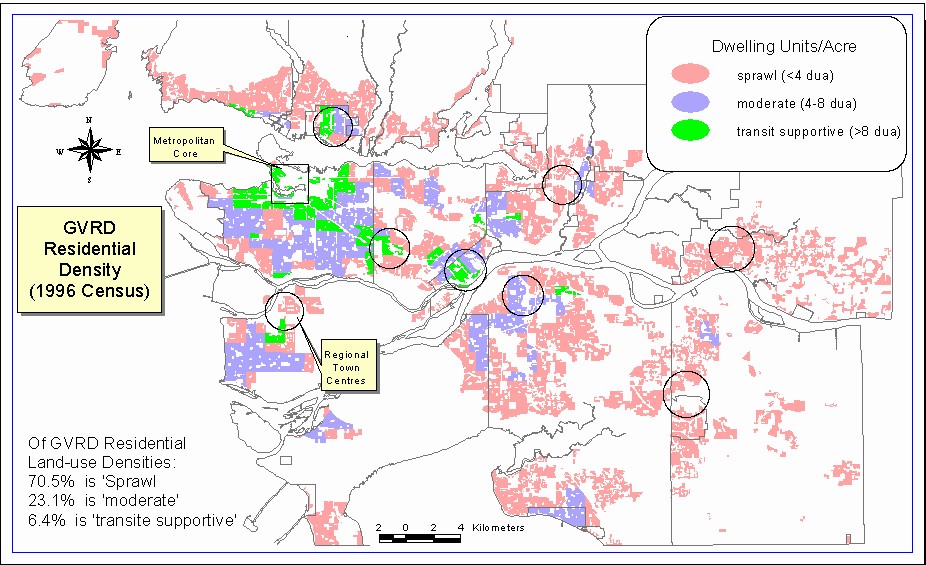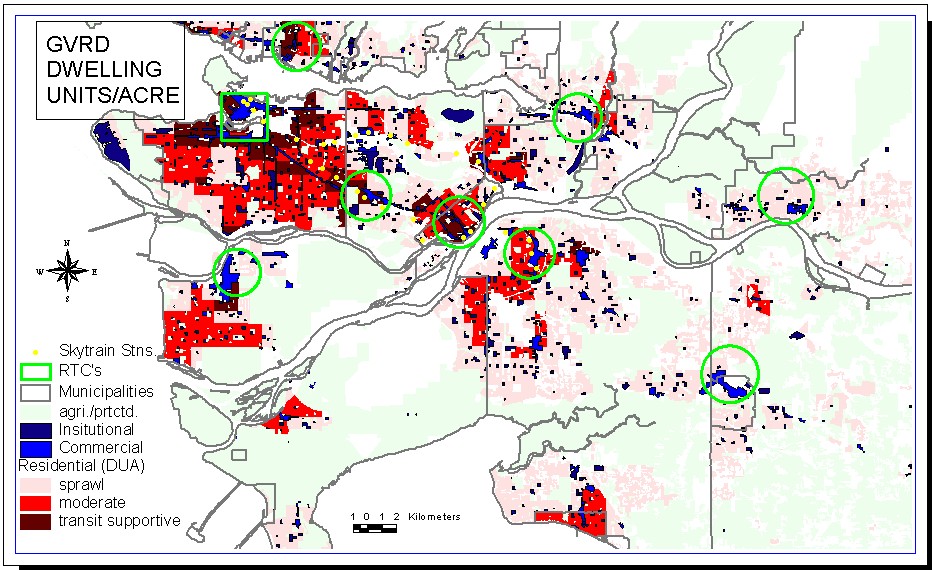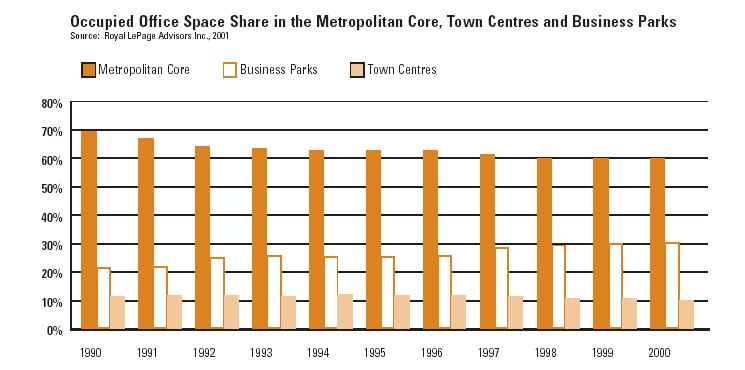
Building a Network of Centres with Job/Labour Force Balance.
A network of centres containing a balance and concentration of jobs and housing is central to GVRD sustainability objectives. Between 1986 and 1996, the GVRD added approximately 160,700 dwelling units. Of all the new housing units completed in this 10-year period, only 16 per cent of them were located in regional centres, roughly 11,000 (6.9 per cent) of these in the metropolitan core and less than one tenth, roughly 14,700 units (9.2 per cent) in regional town centres (GVRD, 2001). Although there has been a moderate increase in dwelling units added to regional town centres, the overwhelming majority of new residential development has occurred outside of regional town centres.
The map below shows the 1996 distribution of dwelling unit densities in relation to the Metropolitan core, the Regional Town Centres (RTC’s), and the municipal town centres. We can see that there is some high, transit supportive density in some regional centres including the metropolitan core, the City of North Vancouver, New Westminster, and to a lesser extent, Metro-Town and Richmond Center. However, many regional centres such as Langley City, Coquitlam Center, Maple Ridge Town Center, and Surrey City Center exhibit mostly sprawl densities, i.e., densities below 4 dua, and a very small amount of moderate densities, i.e. densities between 4 and 8 dua. None of these four RTC’s exhibit transit supportive densities.
A key strategy for creating complete communities is to focus residential growth and densities around commercial and institutional land-uses. The map below shows the degree to which existing 1996 commercial and institutional land-uses were supported by dwelling unit densities. While relatively well supported by densities in the cities of Vancouver, North Vancouver, New Westminster, and to a lesser degree Burnaby, Richmond, Coquitlam, and some parts of Surrey, commercial and institutional land-uses throughout the rest of the region were surrounded by some moderate but mostly sprawl densities.

Although there has been some increase in the number and diversity of housing units in several centres, the overwhelming majority of new office space construction is occurring in business parks typically located at dispersed and isolated locations on urban and suburban fringes of the region. And while the amount of office space in business parks continues to rise, occupied office space in the metropolitan core and in regional town centres is in fact decreasing. Over a 10-year period from 1990 to 2000, the share of regional office space in the regional town centres declined from 10 to 11 per cent, while the share in business parks increased from 20 to 30 per cent, with half of all new office construction occurring in business parks and only 6.6 per cent occurring in the RTC’s (Royal LePage Advisors Inc., 2001). Fortunately, a significant amount of office space continues to be located in the metropolitan core, providing good access to the regional transit system.

The broad picture of how well the region is achieving the objective of building complete communities in a network of centres described by the analysis above shows that although there are some promising signs, the goals outlined as part of this objective are far from being achieved. Although there has been an increase in the diversity of housing types across the region, and some increase in densities, SDD’s continue to make up a significant amount of new housing construction in the region continuing to consume by far the largest amount of the available land-base. Further, housing, and to a greater extent office space, continues to be mostly located outside of the regional town centres. Where new housing is occurring in existing centres, a significant amount of this is being achieved in the metropolitan core, the historical job and housing centre of the region now for almost a century. The fairly significant spatial polarization across the region based on housing type, and also household income, shows that the "build complete communities" strategy is struggling. As with the transportation objective, this objective and the means of implementing them, in terms of the entire region as a whole, appear to be falling short.Next Page
Home